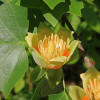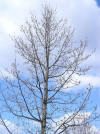WILD
FOODIES' HOME PAGE
PLANT PROFILE LIST
NAME: Tulip Poplar
SPECIES / FAMILY: Liriodendron Tulipifera / Magnoliaceae
OTHER COMMON NAME(S): Tulip Tree, Yellow Poplar, Canary Whitewood
CONDITIONS:
sun-partial shade
|
PARTS: |
EDIBLE |
TASTE |
RAW/COOK |
SEASON |
|
All |
|
|
|
|
|
Shoots |
|
|
|
|
|
Leaves |
||||
|
Stalk/Stem |
|
|
|
|
|
Buds |
||||
|
Flowers |
|
sweet |
RAW/COOK |
Late Spring |
|
Fruits |
|
|
|
|
|
Pods |
|
|||
|
Seeds |
|
|
|
|
|
Nuts |
|
|
|
|
|
Roots |
|
lemon |
|
Fall |
|
Bark |
|
|
|
|
PORTION: small
COMMENT: Nectar from flowers/blossoms & root: For just a short time while the tree is blossoming there is a small amount of very sweet nectar in each blossom. It is heavy and honey-flavored. You can drink it directly from the blossom. The blossom can be tipped and the nectar sipped out. (2) The root is used as a lemon-like flavouring in spruce beer, where it also serves to correct the bitterness of the beer. The bark of the root and branches have a pleasant rather pungent scent.(1)
CAUTION:
NUTRITION/MEDICINAL: Anthelmintic; Aphrodisiac; Cardiac; Diuretic; Nervine; Poultice; Tonic.(1)
LOOK-A-LIKES:
POISONOUS LOOK-A-LIKES:
OTHER USES: Dye; Wood. A gold-coloured dye is obtained from the bark. Wood - fine grained, soft, light, easily worked, durable, brittle, not strong but does not split. A valuable timber, it weighs 26lb per cubic foot and is much used for interior finishes, furniture, construction and plywood. Native North Americans used the tree for making canoes.(1)
SOURCE LINKS (may include nutritional and medicinal info, plus other uses):




